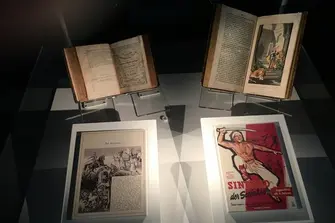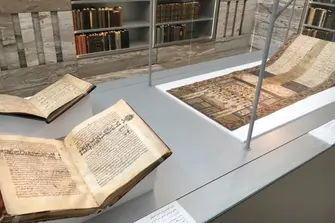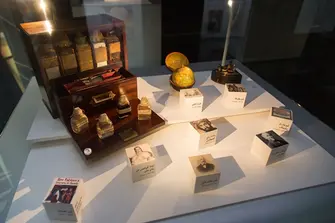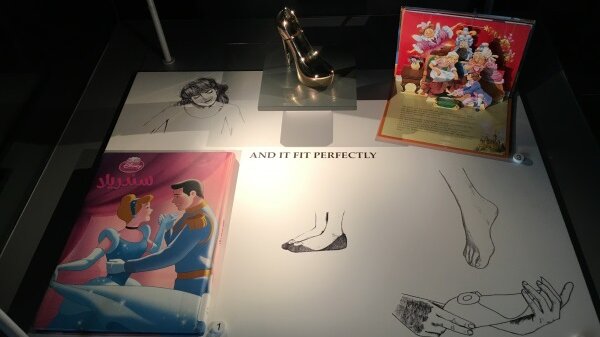About the Exhibition 'Arab and German Tales - Transcending Cultures'
About the Exhibition 'Arab and German Tales - Transcending Cultures'
Storytelling is as old as humanity and at the foundations of civilizations worldwide. Just as cultural practices, religious beliefs, and other aspects of society change through interaction with others, so too do stories. Tales weave between cultures, with each adapting a common story to fit their own unique context. The results are stories that are distinct, yet familiar.
The Arab and German Tales exhibition at Qatar National Library (QNL), a member of Qatar Foundation (QF), which opened to the public on 17 April 2018, traces how some of the best known tales from both Arab and German – and wider Western – cultures developed from common roots, splitting over the centuries to reflect the societies that adopted them.
The exhibition is a joint enterprise between QNL, the Ägyptisches Museum und Papyrussammlung (Egyptian Museum and Papyrus Collection), Staatliche Museen zu Berlin, and the Arab-German Young Academy of Sciences and Humanities. The exhibition features a selection of ancient papyri, rare manuscripts, printed books, illustrations, and other historical items from the Ägyptisches Museum und Papyrussammlung, the Staatsbibliothek Berlin (Berlin State Library), QNL’s Heritage Library, as well as items loaned by other German lenders.
'This exhibition draws from the rich storytelling traditions of a number of cultures, ranging from Western Europe and North Africa to Arabia, India, and Persia. We can see the ways in which these different people interacted with one another through trade and travel, and how, in turn, they adopted and adapted each other’s stories,' says Dr. Sohair Wastawy, Executive Director, QNL.
In particular, two of the most famous sets of tales highlighted in the exhibition reflect the changing nature of stories in both Arabia and the West. One Thousand and One Nights, with its classic frame narrative of Scheherazade telling a new story night after night to stave off execution, synthesizes Indian, Persian, Iraqi, Syrian, and Egyptian tales. These emerged in Arabic in Baghdad before the 9th century, translated from Persian, with Arabic Muslim names and locations replacing Persian ones in many cases.
'Who knows that an elephant ran through the Carolingian city of Aachen as early as 802? It was brought from Baghdad to Karl the Great, the founder of Europe, as a diplomatic gift from Harun al-Rashid, Caliph of the Arab Abbasid Empire. This was a century from which the oldest Arabic version of One Thousand and One Nights dates, stories that were translated in Europe and later decisively influenced the Brothers Grimm in writing their fairy tales. These are just a few examples. This circle could hardly be more international,' says Professor Verena Lepper, Curator of the exhibition and for Egyptian and Oriental Papyri and Manuscripts at the Papyrus Collection in Berlin.
After this early revision, different versions of the story evolved over the centuries, most notably in Syria and Egypt. Ironically, though, some of the most familiar of the Nights tales, such as Aladdin and the Magic Lamp and Ali Baba and the Forty Thieves, were introduced by a Frenchman, Antoine Galland, who integrated Syrian tales into his translation of the Nights. Galland’s translation took Europe by storm, leading to more adaptations and inspiring related works in the West.
Several editions of One Thousand and One Nights are part of the exhibition, showing how the tales evolved and were presented in various ways depending on the time and place.
'One Thousand and One Nights epitomizes the many ways tales evolve as they are shared. We see the change from oral to written transmission, the changing of people and place names to reflect the local context, and the adding and removing of elements to conform with the norms of the culture that now owns them', says Stephane J. Ipert, Preservation and Conservation Manager, QNL.
The other famous set of tales highlighted by the exhibition are those of the German brothers Jacob and Wilhelm Grimm. Like the Nights, Grimms’ fairy tales, which include such classics as Snow White and Cinderella, also drew from existing traditional stories. Many of the tales they adapted came from Italy, France, and Germany, though there is an influence from the Nights as well.
The Brothers Grimm also had to adapt their tales to fit contemporary mores; the first edition of their collection drew criticism for its depictions of violence and cruelty, and they gradually scrubbed such elements, much the same way Disney did when adapting them to film. The exhibition includes items depicting these changes as Grimms’ tales developed into the ones so well-known today.
‘One remarkable thing visitors will take away from this exhibition is just how familiar many of these tales will seem to them, regardless of their nationality or background. Storytelling is a common thread throughout history, and, as this exhibition shows, so too are many of the stories we tell,’ says Ipert.
The exhibition also features some of the earliest recorded tales, written on ancient Egyptian papyri and in poetry. The medieval period is represented by manuscripts from Syria telling stories of the Prophet Muhammad (PBUH) and the Seven Sleepers. These manuscripts reflect the interactions between Germany and the Arab World, including travel narratives and translations of German tales into Arabic and Arabic tales into German.
The exhibition concludes with modern tales and forms of storytelling in Qatar and Germany, inspired by the Arabian Nights and the fairy stories of the Brothers Grimm.
'Who does not know Cinderella? But who knows today's Qatari oral version of this tale? Who knows that the most famous German poet Johann Wolfgang von Goethe himself was able to write in Arabic and that his most famous works of poetry were influenced by Arab authors? There were early travelers who mediated between the Arab and German worlds and exchanged culture,' Professor Lepper concludes.
Date and Venue
17 April 2018
Qatar National Library (QNL), Doha, Qatar
Find More Information Here
Related Exhibitions
- Exhibition in Abu Dhabi 'From Cinderella to Sindbad: German and Arab Timeless Tales' (2021)
- Exhibition Opening in Berlin 'Cinderella, Sindbad & Sinuhe: Arab-German Storytelling Traditions (2019)
- Exhibition 'Cinderella, Sindbad & Sinuhe' in Berlin: A Story of Success (2019)
- 'Arab and German Tales' Exhibition Opens at Qatar National Library (2018)





